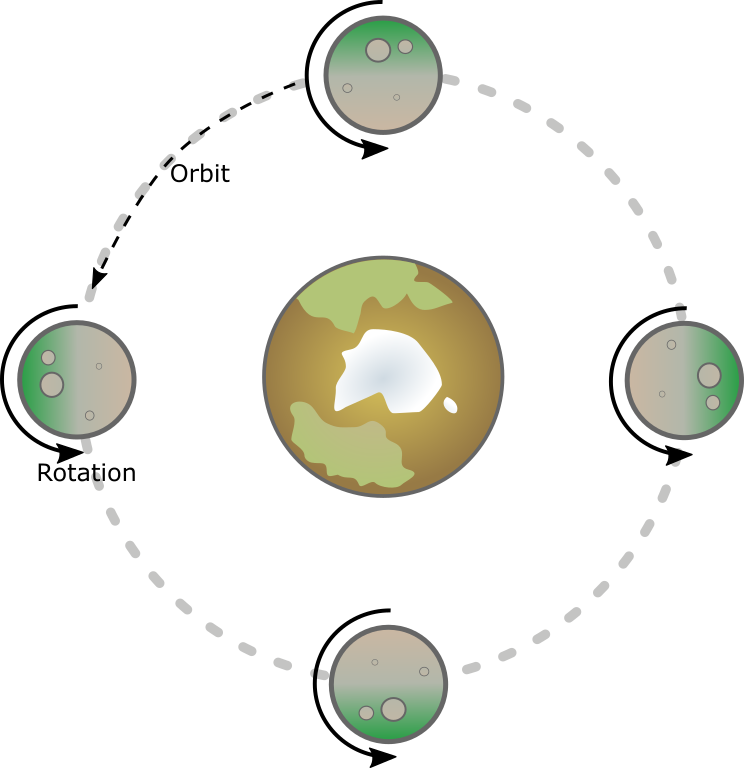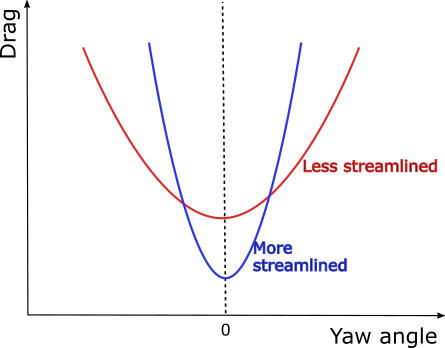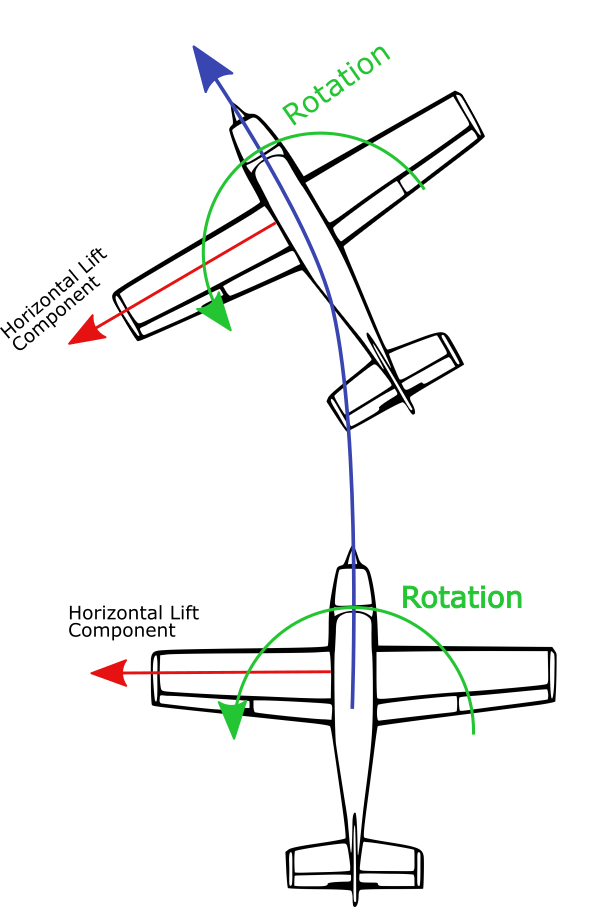First, lets discuss the wrong explanation. Conventional explanation goes something like this. The airplane rolls into a bank. This transfers some of the vertical lift into a horizontal force. The horizontal force becomes the centrepetal force that pulls the airplane in a circular path.
The above explanation may sound reasonable, but at the very least it is inadequate and overly simplistic. This explanation also says nothing about why we need rudder during a turn.
Two separate motions are involved when moving along a circular path. First, there is an acceleration towards the center of the turn. The horizontal component of lift is the source of this acceleration. Second, the aircraft needs to rotate about its vertical axis (yaw axis) to keep pointing in the direction of travel. This is the axial rotation. Both of them have to occur in the correct manner for an airplane to make a turn.
To understand these two motions, lets consider the moon rotating around the earth. The earth’s gravitational force pulls the moon into a circular orbit. This orbit takes 27 days. In addition, the moon is also free to spin on its own axis at a different rate. It turns out that both these rates have exactly the same period of 27 days, producing what is known as synchronous orbiting. As a result, the same part of the moon faces earth all the time. This is not always the case with other orbits. For example, the earth goes around the sun in one year. During that time, the earth would have rotated on its axis 365 times. The reason the moon makes a synchronous orbit, but the earth doesn’t, has to do with a separate force known as tidal friction. There is no tidal friction between the sun and the earth, so the earth’s orbit and its axial rotation are completely different.

When an airplane makes a turn (i.e., orbit around a point), we want the same side of the airplane pointed towards the center of the turn. In other words, we want synchronous orbiting. The horizontal component of lift will produce orbiting, but it will not make the orbit synchronous. There has to be another effect, similar to the tidal friction, to make the aircraft rotate around its own axis (yaw axis).
Having said all that, we do know from experience that when we bank the airplane, the nose rotates into the turn (although momentarily it does turn away due to adverse yaw). In other words, it automatically makes a synchronous orbit. The horizontal component of lift does not impart any rotational effect on the airframe because center of lift and center of mass of an airplane are at exactly the same location. So what is the source of this “tidal friction”? That is the question we are exploring here.
It all has to do with the self-aligning tendency of a streamlined object, also known as the weather-vaning effect. An aerodynamically streamlined object will always turn into the relative wind to minimize its drag. A more streamlined object will have a lower drag when pointed into the wind, as well as a sharper increase in drag with increasing yaw angle. This is illustrated in the adjacent figure. Whenever the nose of the aircraft is not pointed into the relative wind, the excess drag will produce a restoring turning force. This is the force analogous to the tidal friction on the moon.
So lets look at a more complete explanation for how airplanes turn. First, the airplane is banked. This produces a lateral force that pulls the airplane sideways into an orbital path. Next , due to the weather vaning effect, the airframe will rotate to align with the relative wind. If the airframe is highly streamlined, it will quickly align with the relative wind. A less streamlined airframe will need some extra help. This where rudder comes in. When an airplane does not align perfectly into the relative wind, the pilot has to use rudder to manually increase the rotation of the airplane. This is why the amount of rudder needed to make a co-ordinated turn varies from one airplane to another. Additionally, the weather-vaning effect is a function of speed. An airplane will quickly align into the relative wind at high speeds. As a result, we don’t need much rudder in a high speed turn. Similarly, an airframe that is highly streamlined will also not need much rudder during a turn.
So here is the takeaway from this discussion. Airplanes turn due to two fundamental forces. The first force is the horizontal component of lift when an aircraft is banked. This produces the orbital motion. The second is the rotational force on the airframe. This comes primarily from the weather-vaning effect, but it has to be supplemented by the rudder. For the purpose of this discussion, we have ignored engine and propeller related effects such as p-factor, spiraling slip stream and adverse yaw.


Leave a Reply